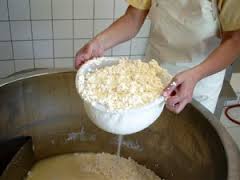 Rennet is an extract from the fourth stomach of calves and contains as its active ingredient chymosin, a milk - clotting enzyme.
Rennet is an extract from the fourth stomach of calves and contains as its active ingredient chymosin, a milk - clotting enzyme.
Soak pieces of the (4th) rennet bag in saltwater (clean, dry). 1 particle can coagulate to 5,000 particles milk. One liter of calf rennet is sufficient to ensure coagulation of 10,000 liters of milk (at 34°C) within five minutes.
In Hasana, Turkeye they slaughter a kid goat. The hard cake of undigested milk in the stomach is to make rennet.
I suspect that the (rennet) stomach of each fledgling ruminant ( grazer) contains the same substances in order to digest the first milk.
Vegetable rennet
Because you do not always have a fresh calf available, even no abomasum , herbal alternatives are also useful . Be used for this include:
- extracts of mallow, cardoon flowers and yellow bedstraw, thistle, the fruits of cleavers, oak bark and bark of willow or alder. Also juice of sour fruits can be used as rennet. Even pea pods.
- in Britain: butter herbs , artichoke, teasel thistle and thistle.
- In Italy is also coagulated with citric acid or nettle.
- Portugal : thistles, also dried flowers of wild cardoon ( Cynara cardunculus ) which is related to the artichoke (Cynara scolymus).
- The German word for bedstraw is Labkraut and lab = means rennet.
- Sweet woodruff (Galium odoratum, Greek gala = milk). Plants of the bedstraw are suitable for the manufacture of cheese to curdle milk.
- Canary Islands: dried flower heads of the cardoon varieties (artichoke thistle -like species) Cynara cardunculus var. ferocissima and Cynara scolymus for "Queso de Media Flor de Guía ."
Penicillium roqueforti is a fungal species which (in powder form) is used to internally let blue mold cheeses such as Roquefort, Danish Blue and Stilton for the characteristic flavor.
Cheese grater: violent book for blind.
Cheese: reincarnation of milk.
